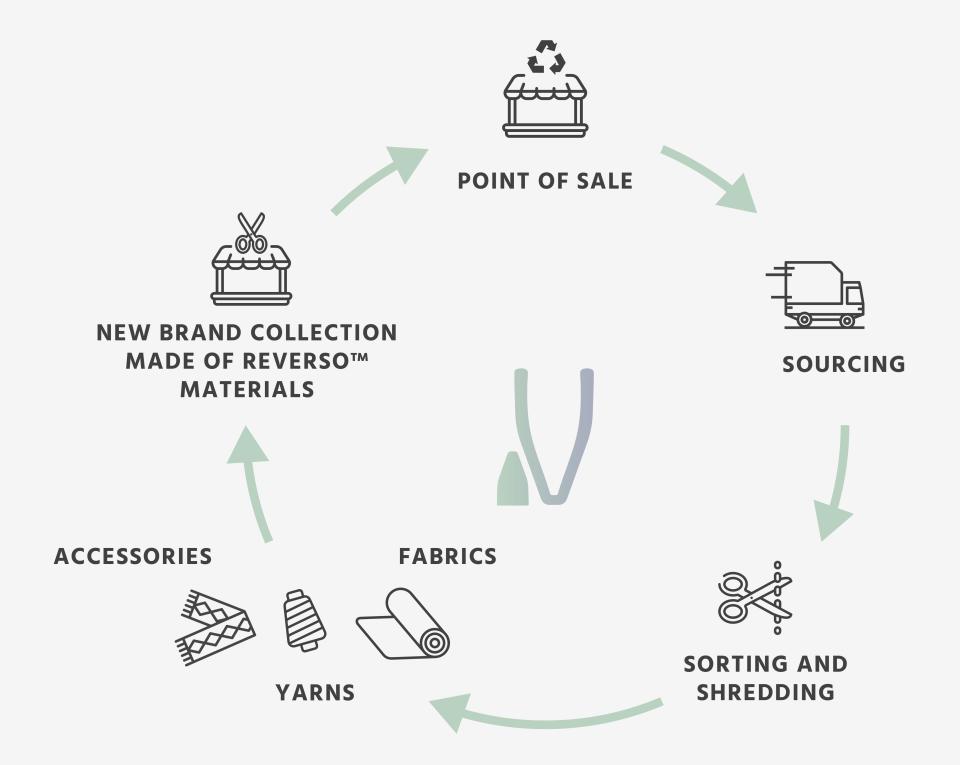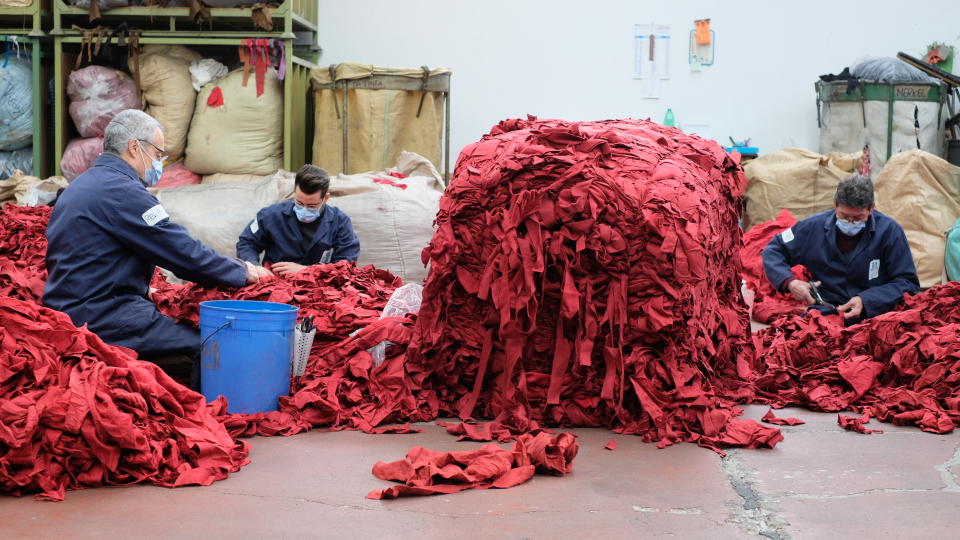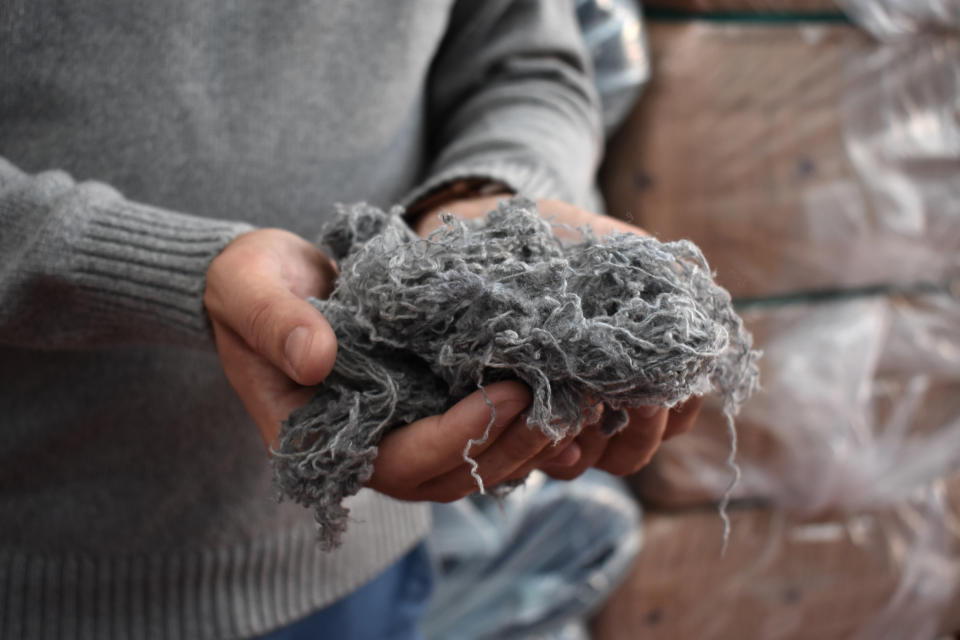Fashion’s Many Lives

- Oops!Something went wrong.Please try again later.
he average consumer throws away 70 pounds of clothing per year, globally accounting for nearly 13 million tons of textile waste each year – those unwanted textiles, however, could be reused, upcycle and made new. According to a study by the Ellen Mac Arthur Foundation, currently only 13 percent of textiles are recycled in some way after being used, while another 12 percent is used in lower value uses that become difficult to recycle with just 1 percent is recycled into new clothing.
“It’s a long way to go,” said Marco Signorini, Head of Marketing of Re.Verso™, the circular recovery and processing service that now aims to make post-consumer waste a thing of the past.
More from WWD
The company, used by brands including Stella McCartney, Eileen Fisher, Patagonia, Ferragamo, Gucci and All Saints, among others, boasts a supply chain that is fully transparent and certified by the Global Recycled Standard (GRS). By re-engineering wool, cashmere and camel using both pre-consumer and post-consumer waste, the company is allowing brands to create yarns and fabrics collections with regenerated textiles.

Courtesy Image.
Put simply, Reverso’s integrated supply chain processes items we no longer wear, or “post-consumer waste,” the company can ensure maximum reuse of materials, offering brands the opportunity to create new collections from regenerated textiles such as yarns, fabrics and accessories from post-consumer waste.
A Life Cycle Assessment analysis conducted by Prima Q found Re.Verso’s cashmere used 82 percent less energy, 92 percent less water and produced 97 percent less Co2 emissions. And Re.Verso’s wool was reported using 76 percent less energy, 89 percent less water and produced 96 percent less Co2 emissions.
Aside from assuring dedicated research and development to ensure completely traceable production, the company is committed to creating high quality, beautiful “Made in Italy” fabrics. Notably, in an official statement, Stella McCartney, a leader in sustainable practices in the industry, said the company uses Re.Verso’s recycled cashmere not only because the environmental impact is seven times lower but also noting that the material offers the “same soft, insulating qualities as virgin cashmere.”
Taking its capabilities to the next level, Re.Verso’s has also introduced a Take Back Program where enabling brands to rework materials from their own previous collection to create new textile fibers season after season through a collaborative circular economy. The last two major customers to join the Take Back program are Danish company Pure Cashmere and German company Unger Fashion.
“We started the Take Back program thanks in part to many requests and confirmations coming directly from industry-leading brands about the ability to take back post-consumer items from their customers,” said Signorini. “These brands were already our customers, for the purchase of Re.Verso™ regenerated yarns and fabrics, so the idea to recover the used knitwear presented an exciting, new way to collaborate, creating true circularity”

Courtesy Image.
Important to note, he said, is that unlike pre-consumer materials, garments that have been taken back from the final consumer by a brand provides the company with the preexisting knowledge of the quality of garments – ensuring the ability for the material to be regenerated into new Re.Verso yarns and fabrics.
In practice, the Re.Verso™ Take Back Program is an innovative and cost-effective in-store collection that engages consumers, offers a reward incentive, drives in-store traffic and sales and provides a global reach, encouraging consumers to use clothing in a more sustainable way, showing how they can make a difference in their communities.
In Re.Verso’s collaborative circular economy, partnerships are the foundation. “Ours is a local supply chain composed of 5 strong and historical local partner companies in the Italian textile district,” said Signorini. “Each partner has its own vertical capabilities from the collection of textile scraps to the production of Re.Verso™ yarns and fabrics. Ultimately, we don’t have suppliers, we have an integrated system.”
These integrations, Signorini said, are the key. “Through openly share information about how, where and by whom a product was made and then publishing that information about every element in the production process from beginning to end, we can build trust that will ultimately provide even more transparency and measurable success across the fashion industry.”

Courtesy Image.
“More often than not, it’s not just the consumer who finds himself bewildered by the world of sustainability,” said Signorini. “It is also the brands themselves that need help, always looking for truly sustainable and circular solutions. They need to find the right partner that, internally, can provide solutions and become a guiding light to allow the brand itself to provide the right information to their community.”
Inclusive participation
Importantly, in its nature, Re.Verso’s Take Back program has been designed to be inclusive and requires participation at multiple stages, offering the opportunity to involve the final consumer in the process.
A huge advocate for transparency, Re.Verso™ has seen the need for brands to communicate and involve consumers in the process. In considering the consumer’s perspective Signorini said, Re.Verso™, and its brand partners, recognize that people want to make more ethical and sustainable choices when shopping, but that in order to do that they need to be informed about what is happening in the industry and what brands are doing specifically.
Notably, the COVID-19 has had a great impact on the consumer, with an even more environmentally conscious shopper emerging from the pandemic. “This has been like a black swan event,” said Signorini. “It is making people think more about balancing what they buy, buying less but better, and recognizing how they spend their time with overarching global issues of sustainability. I think people are tired. They don’t want to be played anymore – they want the truth in order to make truly informed purchasing choices.”
In building a collaborative circular economy, Re.Verso™ will continue to encourage brands to enable to consumer to be free to make choices by offering information readily. “I think that the best practice for brands engaging the final consumer in the process is to make the same process transparent and involve them at all stages of it,” said Signorini. “Consumers have the right to know how a brand impacts the issues they care about and that’s where transparency in fashion comes in!”
To help provide transparency in the industry, and show what can be done, Re.Verso™ will provide a structured report on the main environmental savings for brands to incorporate into marketing and communication strategies.
To learn more about Re.Verso CLICK HERE.
Sign up for WWD's Newsletter. For the latest news, follow us on Twitter, Facebook, and Instagram.

